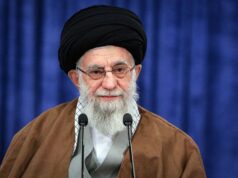Even with the intense international focus on Iran, its nuclear weapons program, support for jihad and Sharia, and horrific human rights abuses, there is relatively little attention paid to the ideology that infuses the mullahs’ regime with such hostility. That ideology is firmly rooted in both historical Shi’a Islam and the deep personal antagonism of the late Iranian Supreme Leader Ayatollah Ruhollah Khomeini towards Jews, non-Muslims, and all things secular and Western.
Ayatollah Khomeini’s seminal doctrine on Islamic governance, velayat-e faqih, described his vision of a just society ruled by a Shi’a jurist in strict adherence to Islamic law, or Sharia. The model for such a ‘perfect’ society exists forever in the minds of both Shi’a and Sunni Muslims as the idealized community of Islam’s early years, when the Muslim prophet Muhammad and his immediate successors ruled as the political and theocratic supreme authority. As Supreme Leader of Iran, Khomeini cast himself in the role of modern-day successor to the Twelve Imams whom the Shi’a believe inherited the mantle of leadership directly from Muhammad, solidifying the Supreme Leader of Iran’s role as ruler of today’s world Shi’ite community, and the Islamic Republic’s position as the modern Shi’ite state.
Origins of the Divide
Shi’ite Muslim belief in the specific identity of the Mahdi as the Twelfth Imam provides a good marker for the dividing line that separates Islam’s two major sects: the Shi’a and the Sunni. That division is the oldest and deepest split in the history of Islam and dates to the reported disagreement over who would succeed Muhammad upon his death in 632 CE. According to Islamic tradition, when Muhammad departed the scene, he left behind a community of believers poised to complete the military conquest of the Arabian Peninsula and spread the new creed by rape, pillage, and slaughter across large swathes of the known world. What Muhammad apparently did not leave behind was a son. Islamic scholars point to the Quran for the explanation of why there could not be a direct male heir: “Muhammad is not the father of any male among you, but he is the messenger of God and the seal of the prophets; and God is aware of all things” (33:40).
While apparently solving one problem, though, the Islamic decision to depict Muhammad as without a son led directly to intractable internecine warfare over who then should be named his successor. In the decades following Muhammad’s death, those closest to him disagreed violently over this question. The family of his daughter Fatima (who married Muhammad’s cousin, Ali, and produced two sons, Hassan and Hussein) asserted a spiritual right of the bloodline, calling themselves the ahl al-bayt (or people of the house—of Muhammad). But others among the close Companions argued for Abu Bakr, who was chosen instead as Caliph by the majority who saw succession as a political issue. Those who supported Abu Bakr came to be known as “Sunni,” meaning “those who follow the Sunnah” (what Muhammad was recorded as having done or said during his life). Those who supported Ali came to be known as “Shi’a,” which is a contraction of the phrase “Shiat Ali,” meaning partisans of Ali. By the 21st century, Sunnis comprised some 85 percent of the world’s 1.57 billion or so Muslims, while Shi’ites largely made up the remaining 15 percent.
Ali was passed over two more times, as the position of Caliph went from Abu Bakr (632-634), to Umar (634-644), and then Uthman (644-656). Finally, when Caliph Uthman was murdered in 656, Ali became the fourth of what Sunni and Shi’a alike call “The Four Rightly Guided Caliphs.” Aisha, Muhammad’s widow, opposed Ali’s appointment as Caliph and accused him of complicity in Uthman’s killing; she even raised an army against Ali, but was defeated at the Battle of Basra in 656, after which she apologized to Ali and withdrew from public life. This didn’t end the strife, however, as Caliph Uthman’s cousin and governor of Damascus, Mu’awiya, refused to recognize Ali as Caliph until Uthman’s killers had been brought to justice. Ali ultimately sought a compromise with Mu’awiya, which so outraged some of his own supporters that one of them assassinated him in 661. Mu’awiya became Caliph and Ali’s older son, Hassan, died within a year (perhaps by poisoning). When Mu’awiya himself died in 680, his son Yazid seized control of the Caliphate and Ali’s younger son, Hussein, led an army against him. Hopelessly outnumbered, however, Hussein was defeated and killed at the Battle of Karbala (in today’s Iraq) in 680. Hussein’s infant son, Ali, survived, however, to continue the bloodline of the ahl al-bayt.
Defining Moments
These momentous events at the very origins of Islam set the Sunni/Shi’a split for the next 13 centuries and also the pattern for what would become an endless series of battles within Islam, mostly over power and succession, but also involving theological differences. Hussein’s last stand at Karbala against the Caliph Yazid immortalized the Shi’a worldview as an oppressed but valiant minority who courageously would choose “martyrdom” over submission to tyranny.
Another seminal event that helped define Shi’ite identity as distinct both politically and theologically was the apparent end of the line of Muhammad in the 9th century. Following the death of Ali and his sons, the Shi’ite succession followed from father to son through a series of 11 Imams, believed to be divinely appointed and infallible; however, when the last Shi’ite Imam, Muhammad al-Muntazar al-Mahdi, disappeared as a young boy, the Shi’as insisted that he had gone into hiding (or “occultation”) and would return. When he failed to reappear after several centuries, the Shi’a ulema (senior scholars) decided that leadership of their community would rest in the hands of pious representatives of the Twelfth Imam until he came back. These so-called “Twelvers” form the largest sect within Shi’a Islam, although some revere others among the first Twelve Imams.
In addition, the Shi’ite conquest of 16th century Persia was important, as it set the conditions for the second forcible conversion of the Persian people, this time to Shi’a Islam. Persians, whose ancient monotheistic faith, Zoroastrianism, strongly influenced both Christianity and Islam, were first overrun in the early years of Islam’s expansion. This second conquest explains why about 90 percent of the 98 percent of Iranians who are (at least nominally) Muslim are also Shi’ite. Since the 1979 Iranian Revolution, Ayatollah Khomeini and his successor as Supreme Leader, Ayatollah Khamenei, have revived the Shi’ite belief that the disappeared Twelfth Imam is, in fact, identifiable with the Islamic figure of the Mahdi, whose messianic return will usher in the Day of Judgment and the End Times.
From 7th-Century Shi’ite Eschatology to 21st-Century State Power
Indeed what makes the animating ideology of Khomeini’s successors so dangerous to global stability is not just that Tehran is on the verge of deploying nuclear weapons or that it has collaborated with the most violent Islamic terrorists in some of the most heinous jihadist attacks, but that they believe deeply in their own chosen roles as representatives of God on Earth who are destined to pave the way for the return of the Mahdi. According to Reza Kahlili, a former member of the Iranian Islamic Revolutionary Guard Corps (IRGC) who spied for the CIA, the current rulers of Iran—Khamenei and his top IRGC and military commanders—believe that ancient ahadith (sayings of Muhammad and his followers) predict the events that will usher in the End Times and Day of Judgment and point to key signs that the reappearance of the Twelfth Imam is near. The return of the Mahdi will be expedited by the instigation of chaos, strife, and warfare on earth, including the annihilation of the Jews. The office of Iranian President Mahmoud Ahmadinejad produced a film in 2010, “The Coming is Upon Us,” that describes these alarming beliefs in startling detail. Iran’s seemingly inexorable march to deployment of deliverable nuclear weapons links closely to this eschatology, as does the regime’s enthusiastic support for what it calls “The Islamic Awakening.”
In combining these millennialist Shi’a beliefs with traditional Islamic doctrine on Jew-hatred, jihad, and a relentless quest for a deliverable nuclear weapons capability, the current Iranian regime has arrived at a dangerous intersection of 7th century eschatology and 21st century technology. Historical Shi’ite anti-semitism that reached a vicious zenith under four centuries of Safavid and Qajar dynastic rule beginning in the 16th century is now echoed in the Khomeinist regime of Supreme Leader Khamenei and President Ahmadinejad, which calls for the destruction of Israel and mass murder of Jews. The historical Persian period that pre-dated the relatively more tolerant 20th century Pahlavi Dynasty was characterized by oppressive state-sponsored measures to force previously-Sunni Persians to convert to Shi’ism as well as the harsh treatment of Jews and other non-Muslims that has always typified Sunni majority rule. The mass exodus of Iran’s Jewish population attendant to the 1948 establishment of the State of Israel and Khomeini’s 1979 return to Iran left perhaps fewer than 10,000 Jews in Iran. Consequently, the Khomeinist regime’s revitalization of Shi’ite Islam’s worst anti-semitic tendencies blended with a modern-day fixation on restoration of Levantine Sacred Space to Islam serve to direct Tehran’s venom mostly outward—at Israel.
Borderline hysterical paranoia about Israeli activities, however, still regularly takes aim at Iran’s tiny and utterly cowed remaining Jewish population and finds expression in periodic accusations of collaboration and espionage in the service of Israel. Holocaust denial themes are juxtaposed irrationally with threats to repeat the slaughter that Hitler began. Iranian leadership figures, from the Supreme Leader to Ahmadinejad, IRGC commanders, and parliamentary representatives, routinely invoke traditional Islamic memes about the nefarious role (and morbid destiny) of Jews in Muslim End Times scenarios and merge those with a Khomeinist statal philosophy that, despite its 21st century technology, more closely reflects Shi’ite theocratic pathologies than anything remotely resembling the genuine wishes or even Islamic practices of the battered Iranian people.
The possibility that such a regime may soon demonstrate mastery of deliverable nuclear weapons should be deeply frightening.
Similarities Among Differences
Despite the deep antipathy between Sunnis and Shi’ites over the disagreement about legitimacy that derives from the succession issue, their theological beliefs converge in numerous areas, as can be seen from a comparison of their respective schools of religious jurisprudence (fiqh).
For example, there is virtually no difference between Shi’ite and Sunni beliefs when it comes to jihad, defined in Islamic law as “warfare to establish the religion [Islam],” which mostly resulted in the pursuit of earthly objectives—power, loot, and slaves—but was enshrined in Sharia as a religious obligation, commanded of all Muslims by Allah himself. On the Sunni side of the Islamic divide, following the early split, a series of Muslim political empires (the Caliphates) continued a violent rampage of jihad, defeating Byzantine, Buddhist, Hindu, and Persian empires and decimating pre-existing Berber, Christian, Jewish, and other societies across the Middle East. For its part, Shi’a adherence to orthodox Islamic doctrine on jihad may be seen in its modern iteration in the 1989 Iranian constitution, which not only dedicates Khomeini’s regime to the global spread of his revolution by jihad, but constitutes the IRGC as an ideological army whose duty is “extending the sovereignty of God’s law throughout the world.” Although some assert that Shi’a must await the return of the Twelfth Imam to engage again in jihad, the Khomeini doctrine maps perfectly to that of al-Qaeda, Hamas, the Muslim Brotherhood, and other Sunni Muslim jihadis.
In fact, Sunnis and Shi’ite fiqh are in agreement about most major issues including: belief in Allah and Muhammad as his prophet; abrogation and progressive revelation; the duty of the Dar al-Islam (House of Islam) to conquer and subjugate the Dar al-Harb (House of War) by jihad; the death penalty for adultery, apostasy, blasphemy/slander, homosexuality, the killing of a Muslim without right, and “spreading mischief in the land;” and the basic Five Pillars of Islam—the Shuhada expression of belief, daily prayer, Ramadan fasting, pilgrimage to Mecca, and zakat, the obligatory annual tax. Yet, there are differences in other important theological areas. For example, the Shi’a accept the authenticity of different ahadith than do the Sunni, just as they differ on the concept of ijma, or scholarly consensus—both of which derive from their diverging beliefs about succession issues. Also, in the area of ijtihad, or the scholarly legal interpretation of Islam’s foundational texts, it is said that “the doors of ijtihad closed” on the Sunni side around 900 CE but that they remained open much longer on the Shi’ite side, perhaps even after the 1979 Khomeini revolution, which is noted for a tradition of scholarly debate and inquiry. Others argue that the doors to ijtihad never closed at all for the Shi’ites.
In the area of governance under a religious hierarchy, there are significant differences between Shi’a and Sunni, which help explain some of the enduring animosity, hatred, and vicious sectarian conflict that still flares between these two communities. Examples of brutal sectarian conflict in Iraq, Lebanon, and Syria as well as the harsh Bahraini and Saudi suppression of their respective Shi’ite populations remind us that fitna (internal fighting) is not merely a historical footnote. While Sunnis long ago gave political allegiance to whichever Muslim conqueror or ruler (including non-Arabs such as the Ottoman Turks) was able to seize the reins of power and rule according to Islamic law, the Shi’a established a clerical hierarchy from whose most devout and learned ranks both political and religious leaders were chosen. Shi’ite clerical levels range according to one’s recognized scholarship from a Hojatoleslam to Ayatollah to the highest rank of Grand Ayatollah (or Marja-e Taqlid, one worthy of emulation). Interestingly, when the Ayatollah Khomeini, himself a senior marja, seized power in Iran, his self-image echoed that of a powerful Shi’ite forbear from the 16th century, Muhammad al-Baqir Majlesi, who was given broad political authority by the Safavid ruler Sultan Husayn to convert Persian Muslims from Sunni to Shi’a Islam.
21st-Century Consequences
Whether involving modern nation states or the enduring influence of ancient tribes, the continuing conflict between 21st century Shi’a and Sunni Muslims is, at its roots, about ambition, domination, and greed for political power. With nuclear weapons, oil, and terrorism in the mix, the eschatological elements of Islam’s 7th century feud are magnified with strategic-level ramifications that could affect international security and stability on a global scale.





